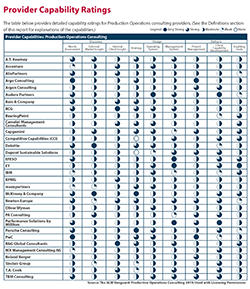Systemic Continuous Improvement

Systemic Continuous Improvement
Author : Performance Solutions by Milliken
Attempts to “improve” manufacturing are driven by problems, not planning. An issue or incident occurs, managers and frontline associates attack, and production returns to normal — for a little while. But eventually the problem recurs — which means no lasting improvement has been achieved.
Why? Because reactive firefighting is all that you can expect without a performance management system that:
- Measures operational outcomes,
- Continuously establishes new, higher goals/benchmarks, and
- Develops innovative standards of practice.
A good performance management system isn’t triggered by a problem or concern; instead, it identifies them before they happen via visual management and communication methods.

ALM Intelligence, a leading expert on the consulting industry, recognizes the importance of systems to support continuous improvement, and includes a “Management System” score in its annual rankings of operations consulting firms. ALM defines this as how client resources are “mobilized, managed, measured, and motivated through governance, incentives, organizational structures, and performance management to execute the strategy.” In 2019, Performance Solutions by Milliken (PSbyM) was one of just three consultancies rated as “Very Strong” in the Management System category.
PSbyM understands the critical importance of a performance management system, as illustrated by the dramatic improvements achieved by its own Milliken Performance System (MPS). Developed for PSbyM’s parent corporation, Milliken & Co., the MPS has helped hundreds of PSbyM clients around the globe to adopt new best practices and achieve record-setting results.
The premise is simple: Many manufacturers don’t achieve sustainable improvement results despite substantial investments of resources, time, and effort. Their efforts lack alignment with overall organizational goals; use improvement tools without specific bottom-line objectives; and/or rely on an improvement group that doesn’t engage frontline associates.
MPS overcomes these issues by helping leaders, managers, and workers to:
- Communicate, monitor, and “own” goals and improvements by area, line, and function.
- Make visible all operations activities and outcomes throughout an organization.
- Establish standardized practices to make informed decisions and implement lasting solutions.
MPS is based on a foundation of employee safety and strategic clarity (i.e., prioritizing and executing the most beneficial improvements), supported by these principles:
- Daily team maintenance provides operators with the knowledge and skills to prevent equipment breakdowns, improve machine reliability, and reduce mistakes caused by equipment problems and abnormalities.
- Continuous skills development is a standardized training process that ensures all associates do the right things, the right way, every time, which decreases process variation, turnover, and overall training spend.
- Focused improvement identifies opportunities for improvement projects with lasting returns based on reducing or eliminating losses.
- Production flow reduces overall costs by eliminating waste and improving working capital and inventory optimization, variable conversion cost, capacity utilization, and more.
- Planned maintenance is a combination of preventive, predictive, and zero-failure maintenance activities that improve reliability, by establishing maintenance schedules to address problems before they occur.
- Quality management helps manufacturers achieve zero quality defects by identifying and eliminating root causes.
- 5S workplace organization arranges and maintains the production environment in ways that increase productivity and safety, reduce waste, and eliminate non-value-added activities.
- Early equipment management uses data analysis and equipment modeling to improve the reliability and stability of new-equipment startups — designing out losses (e.g., start-up time, costs, product defects) before production begins.
- Concurrent new product development brings together all functions to plan, develop, and manufacture new products that satisfy customer requirements and meet internal standards.
PSbyM practitioners help clients to adapt MPS into their own unique workplaces, cultures, and current practices. Adherence to the system and daily routines continuously surface new opportunities for improvement throughout the entire organization.
A performance management system provides the structure and behaviors that drive continuous improvement. Are you tired of seeing your company or plant make changes, only to see problems reemerge? The rapid improvement consulting team at Performance Solutions by Milliken and MPS can help you to break that cycle. If you’d like to learn more about it, contact us today, and begin achieving improvements from the inside out.